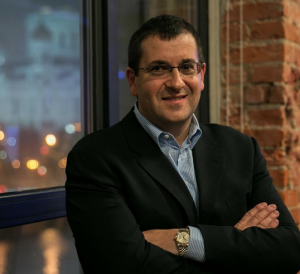By David Goldberg, on Mon Jul 28, 2014 at 1:30 PM ET “We could simply pack our bags and catch a plane to Barcelona ‘cause this city’s a drag.”
– Holiday in Spain by Counting Crows
 If you’re reading this, there’s a decent chance I’m catching you on a mobile device. And according to the latest Pew data, 6% of U.S. consumers are mobile ONLY. No home phone. No computer. And from what I saw at Mobile World Congress(MWC) last month in Barcelona, this number is guaranteed to rise. If you’re reading this, there’s a decent chance I’m catching you on a mobile device. And according to the latest Pew data, 6% of U.S. consumers are mobile ONLY. No home phone. No computer. And from what I saw at Mobile World Congress(MWC) last month in Barcelona, this number is guaranteed to rise.
One of the major conversations at the conference centered on device form factors – they’re getting bigger. Samsung, Nokia and Sony all announced new phones with larger screen sizes, and Huawei showed off its new “phablet,” a phone-tablet combo with a 7.1-inch screen.
The other major trend we kept hearing about is the rise of wearables. Samsung announced a new smartwatch family – the Gear2, Gear Neo, and Gear Fit – while perpetual rumors about a similar Apple device continue to swirl. Things like smartwatches have yet to prove themselves, but simpler wearable technology that tracks daily habits without incorporating other messaging and connectivity components (FitBit, Nike Fuel, etc.) have clearly filled a consumer need.
Another trend that continues to gain momentum is the increasing use of consumer friendly tools and services in a business setting. The trend of people bringing their own devices, or BYOD, has been around for quite some time. It’s now evolved into BYOS – or bring your own services. I participated in a panel discussing BYOD/BYOS, along with executives from Evernote, Merck, AT&T and others.
As part of the panel we unveiled the results of a SurveyMonkey Audience survey to find out how many of us are downloading and using services on our mobile devices at work, independent of those recommended or offered by our employers. Here’s what we found:
Employees are spending more and more time on their phones for work purposes
- Almost 30% (29%) of people report that half of their time – or more – is spent using their mobile phones for work
- More than half of respondents (56%) report an increase in using their mobile phone for business over the past three years
And most believe they will spend even more time on their phone for work in the future
- The majority of respondents (52%) believe that they will increase their use of mobile phones for business in the future
Now that employees are bringing their own devices, they are bringing their own services, software and applications into the workplace
- Slightly more employees (31%) report bringing ALL their own services into the workplace vs. those that only use services approved/suggested/provided by their employer (28%)
- 29% of respondents report using a mix of services/applications that they downloaded themselves and those provided by their employers
- 8% do this a lot
- 8% do this a good amount
- 13% do this some of the time
With productivity tools continuing to be more consumer friendly, like Box, Dropbox, Evernote, Google office apps, etc., and more mobile (we launched our own mobile app last month), this is another trend that will continue to generate lots of momentum. Innovations like these, and the others I saw during my trip to MWC, are going to accelerate the growth of that 6% mobile only number. Gracias, Barcelona!
By John Y. Brown III, on Mon Jul 28, 2014 at 12:00 PM ET
 The “Marshmallow Test,” Batman, and law school (and life) lessons. The “Marshmallow Test,” Batman, and law school (and life) lessons.
Ever since my sophomore year in college, after renting the movie the Paper Chase (about life at Harvard law school) and watching it three consecutive times (the third time as the sun was rising the next morning), I knew I wanted to go to law school.
25 years ago this fall I started law school at the University of Kentucky. Law school, for me, was one of those transitional and transformational experiences. The experience has a way of introducing a student to him or herself. During law school one has to come to grips with realities about himself or herself that can be both humbling and heartening. In my case, law school proved to me that I wasn’t nearly as smart as I had secretly hoped; but proved to others that I was considerably smarter than they had assumed. The experience also proved to me I could work much harder than I thought I could. And proved to my parents that I not only could –but would –work much harder than they thought I ever was capable. It was an important and defining time for me.
A few weeks before heading from Louisville to Lexington for law school a wise mentor took me to lunch and asked me what I hoped to achieve there. I told him I wanted to finish in the top 10% of my class (or Order of the Coif, as it is known in most law schools). He was unimpressed and said he only hoped -–and believed—that after law school he could say that “I was a fine young man.” And that is what was really important. He was right, of course, and over the next 3 years I never forgot his response. But I also never forgot my goal.
Over the past week, I have been texting a friend and law school classmate from a quarter decade ago about our law school experience. What has been most striking is the detail with which we each remember the many facets of our experience, but most especially the detail with which we recall grades and class rank. We each noted if we had had a single class where our grade increased by a single increment (from a B+ to an A – or a B to a B+) we would have graduated law school with a notably higher honor than we did. In my case, I pointed out to my friend, I would have graduated “Order of the Coif.”
And this is where the “Marshmallow Test” comes into play. That test was made famous for demonstrating that young children who could delay gratification (by saying “no” to the tempting offer of a single marshmallow now in favor of being rewarded with two marshmallows 15 minutes later) was a better predictor of life success than any other test devised for young children. What does this have to do with law school? Well, the night before one of my final law school exams, I got invited, cajoled, and ultimately persuaded to scrap studying for several important hours to go see the movie Batman. Prior to that night, I never—ever—had compromised on studying during law school exams. My first year I had no cable TV and would only see and go on dates with my now wife once a week. I missed an aunt’s funeral during first year finals and spent Thanksgivings alone so I could get a possible studying edge on my classmates. But this one time—when I knew I was on the bubble for Order of the Coif and that anything lower than a B would probably drop me below Coif—I went for the “instant” rather than the “delayed” gratification.
I got a “B –“ and didn’t achieve my long held goal of making Order of the Coif. And I had only myself to blame. My former classmate and I, while texting about our “near misses,” concluded that we both took it all too seriously back then and that now, fortunately, we were much less competitive than our younger selves and how that was a good thing.
That is all true. I even added that “Life with our competitive tendencies kept in check,” is much more rewarding, both personally and professionally. But I also had to confess that despite my 25 years of additional maturity and, supposedly, wisdom, I would never have anything nice to say about the Batman movie franchise.
I was joking, of course. But not entirely. The texting conversation made me realize that 25 years later I still know—and can relive— every detail about how I botched my shot at graduating law school with that distinguised honor. But what I can’t do is recall with even the slightest detail any of the movie Batman, which I chose instead that night. In other words, I have no memory of the single marshmallow I chose 25 years ago. But a vivid recall about not holding out for just 15 more metaphorical, and perhaps literal, minutes for the bigger and longer lasting prize I sacrificed.
I like to think I still graduated as a “fine young man” as my mentor friend had hoped for me—and that, in many respects, my goal of wanting to graduate “Order of the Coif,” was just an extra marshmallow I missed out on, so to speak, but nothing much more than that. But the lesson I really learned –and am quite sure I’ll never forget—is that when faced as an adult with the equivalent of the Marshmallow Test, I will remember that the second marshmallow is always much sweeter and more satisfying than the first. If for no other reason, the second marshmallow is worth much more because of the sacrifice required to earn it.
Marshmallows, like life, are like that
By Saul Kaplan, on Mon Jul 28, 2014 at 8:30 AM ET  I have to admit when I was growing up and when we raised our children I thought weird was out. Weird was isolated, ostracized, dismissed, and definitely not cool. Turns out I was wrong. Weird is in. Weird is unique, refreshing, remarkable, and definitely cool. It just took me a while to figure it out. The evidence is all around us. Two personal reminders of how weird can be an advantage are a recent trip to Austin, Texas and reading Delivering Happiness by Zappos CEO, Tony Hsieh. I have to admit when I was growing up and when we raised our children I thought weird was out. Weird was isolated, ostracized, dismissed, and definitely not cool. Turns out I was wrong. Weird is in. Weird is unique, refreshing, remarkable, and definitely cool. It just took me a while to figure it out. The evidence is all around us. Two personal reminders of how weird can be an advantage are a recent trip to Austin, Texas and reading Delivering Happiness by Zappos CEO, Tony Hsieh.
I was asked to give a talk on business model innovation to a group of association leaders in Austin, Texas. It was my first trip to Austin but the city’s reputation for embracing weird preceded my visit. I love the city mantra Keep Austin Weird. How many cities would have the guts to rally around such a weird positioning? I think it is brilliant. It is differentiated and sends a clear message to both residents and visitors that Austin is an edgy and interesting place where creativity is central and you just might learn something new. It makes me want to live and invest there. The night I arrived the positioning was realized immediately as I joined an eclectic crowd forming on the Congress Street Bridge to watch North America’s largest urban bat colony emerge from under the bridge. You don’t experience that every day. It was delightfully weird and the gathered crowd was a great manifestation of Austin’s community aspiration for a collaborative fission of coordinated individualism.
The discussion I went to Austin for with a diverse group of association leaders focused on declining association membership and how to design and test new business models. Turns out that many young professionals are not joining associations and the group wondered if those professionals most receptive to innovation and changing the role of their professions are the least likely to join associations leaving an aging membership uninterested in being and celebrating weird. Maybe associations could benefit from a little more weird.
I just finished reading and highly recommend Delivering Happiness by my friend Tony Hsieh. Tony reveals his Zappos playbook and no surprise weird plays an important role. One of Zappos’ 10 core values is Create Fun and a Little Weirdness. Can you imagine your company explicitly celebrating being weird as one of its core values? Zappos means it. Not crazy or extreme weirdness but comfort with unconventional approaches, learning from mistakes, and the ability to laugh at themselves. Zappos wants a touch of weirdness to make life more fun and interesting for everyone. Tony is serious when he says the company must have a unique and memorable personality.
I experienced the weirdness first-hand when I visited Tony at Zappos headquarters in Las Vegas. It is remarkable to see the Zappos culture up close and personal. If you are going to Las Vegas definitely take Zappos up on its standing offer to visit the headquarters. None of what you have read about Zappos is as powerful as seeing it in action. From the way you are greeted at the airport to a memorable stroll through the company. On the outside the buildings look like any one of a million suburban office complexes but once inside you will not forget the experience and uniqueness of being warmly greeted by each department with an eclectic mix of streamers, parades, kazoos, cowbells and what ever expression strikes the Zappos team at the moment. The Zappos culture Tony talks about is obvious, tangible, and infectious. In Tony’s own words to Zappos employees, ” We want the weirdness in each of us to be expressed in our interactions with each other and in our work.” I am thrilled that Tony is joining us as a storyteller at BIF-6 (not to be missed, hint, hint, only 60 seats remain).
If the goal is to get better faster and learning is optimal at the edge we could all benefit from a little more weirdness. We need to make room in our personal lives, organizations, and communities for embracing weird. Everything else seems boring and stagnant. Weird is in.
By RP Nation, on Tue Jul 22, 2014 at 1:30 PM ET  America is at a crossroads. We sit here on the edge of a fiscal cliff fighting to determine if tax hikes or entitlement reform is going to lead the day. As we fight to raise our debt ceiling critical questions are not being answered and seem to be ignored time and time again. How did we get here? Why did we get here? And how do we avoid getting here again? America is at a crossroads. We sit here on the edge of a fiscal cliff fighting to determine if tax hikes or entitlement reform is going to lead the day. As we fight to raise our debt ceiling critical questions are not being answered and seem to be ignored time and time again. How did we get here? Why did we get here? And how do we avoid getting here again?
When we rescued two of the three American car companies we did so by removing huge debt and the liabilities of their underfunded pension liabilities. Did we address why they were all failing to begin with? Were VW, BMW, and Mercedes in Germany rescued? Did Japan step in to support Toyota, Honda, Nissan, Subaru or Mitsubishi. There are concrete reasons why two thirds of the American auto industry was failing. The truth is that America’s other smaller industries are just as affected but don’t have the glitter and prestige of the auto industry. Many have already disappeared.
Unfortunately, the hidden statistic that never reaches the lips of leaders in Washington is that the United States of America has had 38 years of consecutive trade deficits. Our current account deficit is 10 times worse than the worst country in Europe. The EU as a whole carries a $32 billion trade gap with the world which sounds large until you realize that the United States of America has a trade deficit of $600 billion annually. So the question needs to be asked, how is it that a continent stocked full of high cost socialist governments, scarce natural resources, expensive energy prices, speaking 23 languages, and with a 200 year history of intra-continental war, can out-produce and out-ship the United States of America. Aren’t we the most innovative entrepreneurial land on earth? Are we not the land of Facebook, Google, Microsoft, and Under Armour?
If you ask many of today’s leaders they will tell you that the new order of the day is an economy based on services, or they may tell you that manufacturing has left and will never come back. Some will say the cost of manufacturing in this country is just simply too high. Has anyone told LEGO’s, made in Portugal, or Playmobile, made in Germany that costs are too high? With 300 million people in this country why was it considered impossible to find a few hundred willing to work for reasonable wages so we could outfit our Olympic athletes in clothes made in the USA?
It is time for a reset. As a country we need to reflect upon the structure of how we operate and then begin to make the necessary structural changes – regardless of the blow-back from those seeking to benefit from the status quo. There are many things that need changing as America’s issues are not the result of just one or two burdening policies, but many small issues that together can seem overwhelming. The Chinese call this death by 1000 cuts and we can’t allow this paralysis to threaten the future of our country.
Complicated tax rebates, loans, grants, and special incentive programs while well intentioned, are actually a burden to business, especially small businesses that don’t have the resources to handle them. A business that is losing money cannot use a tax deduction when it is already losing money. What business in America needs are not specialized manufacturing technology centers and special start-up technology programs, what a thriving economy needs is simplification.
An entrepreneur to be successful must focus. They cannot be distracted with complicated tax codes, layers upon layers of insurance protections, human resource processes, burdensome licensing and environmental regulations, and complicated legal contracts. When an organization reduces operational processes it increases efficiencies which in turn creates the necessary focus on providing a better product or service.
Starting a business with core knowledge is not as difficult as some may think. However, growing a business to any substantial size is exponentially harder. Once a business grows to $40 million or 100 people it becomes subject to a bevy of interstate and intrastate rules and regulations that don’t affect smaller businesses. Most companies are completely unprepared both financially and operationally to handle the overwhelming onslaught of regulatory obligations that come when a company achieves these new milestones. It is my opinion that this is one reason you rarely see new small manufacturers opening production plants in the US. The labor regulations, the environment regulations, and necessary permits are just the beginning.
If none of these regulations stunt the growth of a new manufacturer, the product and worker liability burden will surely take a huge bite out of any potential profits. For in America, where companies are not reimbursed for successfully defending themselves in court, the cost of unwarranted litigation is a serious threat. With over 1.2 million licensed legal professionals in America, frivolous litigation is rampant.
We need to be able to stop pandering to the entrenched interests and start creating visibility to the obstacles of business then remove them one at a time. This is not as difficult as it sounds. What is difficult is finding those with the courage to get this done.
Jay Steinmetz, CEO of Barcoding Inc. is a Member of the Maryland Small Business Commission
By Matt Ranen, on Fri Jul 18, 2014 at 1:30 PM ET  The debate over what the FCC should do in regards to net neutrality is getting a lot of coverage these days. It’s no wonder, since where the policy lands will have immediate impact on profits and strategies in the media industry. But more generally, this is also a debate over our assumptions about and aspirations for what we want the Internet to be, and whose values are most important to respect. Is “open” more important than “speed” and “innovation”? And which type of innovation is most valuable given today’s economic and social context—one very different from the late 90’s boom time. The debate over what the FCC should do in regards to net neutrality is getting a lot of coverage these days. It’s no wonder, since where the policy lands will have immediate impact on profits and strategies in the media industry. But more generally, this is also a debate over our assumptions about and aspirations for what we want the Internet to be, and whose values are most important to respect. Is “open” more important than “speed” and “innovation”? And which type of innovation is most valuable given today’s economic and social context—one very different from the late 90’s boom time.
Turns out, this is just one of a number of more broadly impacting policy issues that are about to come under the microscope of public debate and government action (or, inaction…which itself is also a choice), as the Internet and the “online” economy of digital goods and services re-integrates with the “offline” or “real” economy.
One of those issues will be about data—big and small—and the property rights assigned to it. There is no need to repeat the hype about how big data is changing everything. Everything from the mundane (cost effective 1 hour delivery!) to the profound (our understanding of climate change impacts!) will look to use data—about individuals, groups, places and things—to find patterns that suggest ways to improve services or deepen our understanding of how our world really works. And as with most technological revolutions, the ability to use data most effectively will lead to changes in who has the potential to hold power within an industry.
But because most of the applications for big data so far have resided in either niche areas or beyond the public’s view, we have not yet seen what happens when the promise of ‘better with data’ rubs up against real human lives and emotions on a large scale. As data-enabled business models grow in their reach and have more economic impact, more questions loom and will have to be addressed by the consuming public, regulating agencies, or the courts. For example: is your refrigerator or car or any other high end consumer good a natural monopoly when it comes to the data it collects? Who should have access to your consumption patterns—just the company that made the product? To what extent is targeted pricing—which some would label as simple a highly efficient market clearing mechanism—discriminatory? When is it okay to essentially make public information about someones’ private life through commercial behavior(e.g. Target and its infamous promotion of pregnancy products)?
Read the rest of…
Matt Ranen: GROWING PAINS FOR THE INTERNET ECONOMY
By Will Meyerhofer, on Thu Jul 17, 2014 at 1:30 PM ET  Here’s what you never hear anyone say at a Biglaw firm – followed by a discussion of why you never hear anyone say it. Here’s what you never hear anyone say at a Biglaw firm – followed by a discussion of why you never hear anyone say it.
Here we go…
Let’s work on this together. It’ll be more fun.
People write me all the time, complaining I’m too down on Biglaw. Nothing new there, but one guy, recently, expanded on the topic, adding that he works at a firm where everyone, so far as he knows, is happy – enjoying a rewarding career in a supportive, non-exploitative environment.
Perhaps you can see this coming: It turns out this guy owns the firm – and specializes in oral arguments before federal appellate courts. Prior to becoming managing partner, he attended top Ivy League schools.
By way of a reply, I opined: “Your experience might be considered atypical.”
In reality, his experience should be considered ridiculously atypical. Redonkulouslyatypical. Yet this presumably brilliant legal mind couldn’t manage to grasp that reality from where he was standing – at the top of the heap.
This man claims, without irony, that every lawyer at his firm is happy. But, that little voice in the back of your head begins to counter, before you’re even aware of having the thought: it’s your firm.
They work for you. Of course they act happy, just as the maid cleaning your hotel room – the one without a green card, with a family to feed, smiles and acts delighted to see you when you pop in to grab your extra iPad mini and she’s on her knees scrubbing the shower.
Presumably, someone else, some possibly unhappy little person at this guy’s law firm, is doing the work he would rather not think about – the work that has to be done. Maybe it’s a junior he’s never met. And I’d bet good money that other guy’s doing it all by himself, probably late at night or on a weekend.
Read the rest of…
Will Meyerhofer: What You Never Hear
By Brooke Masters, on Wed Jul 16, 2014 at 1:30 PM ET  When most US investors do not like the way a company is heading, they vote with their feet and sell their shares. But a new generation of activist investors is challenging that tradition by opting to amass shares and demand board representation and strategic change instead. When most US investors do not like the way a company is heading, they vote with their feet and sell their shares. But a new generation of activist investors is challenging that tradition by opting to amass shares and demand board representation and strategic change instead.
Hertz, the car rental group, became the latest US company to come under such pressure. It is now said to be considering selling or spinning off its equipment hire business after stakebuilding by investors including Dan Loeb and Carl Icahn.
While activists have been around for decades, the scale appears unprecedented. Such hedge funds were managing $90bn as of last year’s fourth quarter, almost triple the total five years ago, according to Hedge Fund Research.
By David Goldberg, on Tue Jul 15, 2014 at 1:30 PM ET “But if you never try, you’ll never know”—Fix You, Coldplay
 Ten years ago, before I was a husband and father, I learned that giving flexible work hours to your best people is a great way to keep them. I was running Yahoo Music, and my senior business development leader, Karin, was doing a terrific job but needed some time at home after the birth of her first child. She asked me if she could work four days a week and get paid 80 percent of her full-time salary. Because she was a star performer, I agreed, though we hadn’t allowed people to work part-time before. Karin did a great job, and we never really noticed that she was out on Fridays. When her second child was born, she wanted to travel less. We switched her into a product development job, still at 80 percent time. She not only flourished but was eventually able to take on a general manager role at Yahoo in another group because she had experience in both business and product development. Karin has continued to progress in her career as a successful leader, and managed to keep her 80 percent schedule until her kids were in school full time. Ten years ago, before I was a husband and father, I learned that giving flexible work hours to your best people is a great way to keep them. I was running Yahoo Music, and my senior business development leader, Karin, was doing a terrific job but needed some time at home after the birth of her first child. She asked me if she could work four days a week and get paid 80 percent of her full-time salary. Because she was a star performer, I agreed, though we hadn’t allowed people to work part-time before. Karin did a great job, and we never really noticed that she was out on Fridays. When her second child was born, she wanted to travel less. We switched her into a product development job, still at 80 percent time. She not only flourished but was eventually able to take on a general manager role at Yahoo in another group because she had experience in both business and product development. Karin has continued to progress in her career as a successful leader, and managed to keep her 80 percent schedule until her kids were in school full time.
When I became CEO of SurveyMonkey four years ago, I used this lesson in flexibility to help attract outstanding senior executives. Today, 40 percent of our senior executives are women with children, an unusually high number in the technology industry. I was able to hire Selina, our senior vice president of product and engineering, by having this elastic approach to hiring great people. At the time, Selina was four months pregnant with her first child. She had many opportunities to start or run her own company (she founded Evite when she was at Stanford), but I was able to persuade her that she could have both a huge impact and more flexibility by joining us than she would have by doing her own start up.
Minna, whom I hired early on to run SurveyMonkey’s international business, had taken a year off after her second child was born and was hesitant to commit to full-time work. I convinced her that she could work four days a week, like Karin, and I was confident that 80 percent of Minna was more than 100 percent of most people we could have hired. Brad, our head of user experience, was very interested in joining us, but he and his wife were expecting their first child and were concerned about his hours, wondering if it made sense for him to jump to a smaller company. Selina and I took Brad and his wife out to dinner and convinced both of them that it could work better—that if he joined our team, Brad would be able to be around more for his family by working a day a week from home.
Too often we focus on titles, compensation and perks to attract great people. I have learned that giving talented men and women flexibility and trusting them to excel has been key to hiring and retaining a great team.
The author is the Founder and CEO of Survey Monkey. Read his full bio here.
By Saul Kaplan, on Mon Jul 14, 2014 at 8:30 AM ET  I have been thinking about regeneration. While it is common knowledge, it still amazes me, that salamanders can regenerate body parts, including their tails, upper and lower jaws, eyes and hearts. Yet mammals including humans can’t. Salamanders are the highest order of animals capable of regeneration. Do mammals know something that salamanders don’t? Cosmetic surgery, implants, and promising regenerative medicine research aside we humans are stuck with the body parts we are dealt for now. I have been thinking about regeneration. While it is common knowledge, it still amazes me, that salamanders can regenerate body parts, including their tails, upper and lower jaws, eyes and hearts. Yet mammals including humans can’t. Salamanders are the highest order of animals capable of regeneration. Do mammals know something that salamanders don’t? Cosmetic surgery, implants, and promising regenerative medicine research aside we humans are stuck with the body parts we are dealt for now.
I wonder if our inability to regenerate at the biological scale also impedes our ability to regenerate at a social system scale. It seems obvious that our important social systems including education, health care, and energy need serious regeneration. These systems have evolved over a long period of time, were built to support an industrial era that is long gone, and have built up incredible mechanisms to resist and prevent needed change. It is not technology that is getting in the way of social system change. It is humans and the organizations we live in that are both stubbornly resistant to change. Why are humans so incapable of regeneration at both biological and social scales?
Maybe understanding the biology of regeneration can provide insight. Salamanders can regenerate injured body parts because evolution has enabled them to immediately unleash stem-like cells to a wound site when damage is detected. When salamanders are wounded skin, bone, muscle, and blood vessels at the site revert to their undifferentiated state. In essence they go back to an embryonic state and start all over again making regeneration possible. Humans took a different evolutionary path.
Turns out the human evolutionary pathway traded off regeneration in favor of tumor suppression. In order to decrease the risk of cancer and increase longevity our mammalian ancestors selected against regeneration. The theory is rapid cell division required for regeneration looks to our bodies a lot like the unchecked growth of cancer. Because our longevity makes us vulnerable to accumulated DNA mutations we’ve evolved a kind of molecular brake to keep tumors at bay. I can’t speak for humankind but it seems like the right trade-off to me. Unlike salamanders, when mammals lose a limb the body’s reaction is to release cells to the site that become scar tissue. Current stem cell research is promising and offers the future potential for a work-around to enable regeneration without turning off the molecular brake that prevents tumor formation and progression. Tissue generation and regenerative medicine are both exciting fields to watch.
I think there are parallels at a social system scale. Social systems have also evolved selecting for traits that maximize longevity. Our current education, health care, and energy systems are well intentioned and pedaling very hard to deliver value. The truth is these systems are no longer positioned to deliver value the way we want and need them to. We all know there is a better way. The 21st century screams for system regeneration and yet the best we seem to be able to do is tweak current models and to leverage technology in a sustaining way to coax more life out of systems that are not sustainable. The evolutionary pathway for our current social systems seems to have traded off regeneration in favor of innovation suppression. I know it seems extreme to equate innovation to a cancerous cell in an organization or social system. But hey, I have seen and worked in many organizations and systems, in both the public and private sectors, which have built up incredible defenses to insulate and protect themselves from innovation and change. Tell me you haven’t experienced the same thing? Our social systems have evolved antibodies to attack and wear down innovators. Organization and system leaders fear metastasis of disruptive technologies and seeds of change. They have established an armamentarium of tools to resist and block regeneration.
We don’t need more tweaks. We need system regeneration. Just like tissue engineering and stem cell research is opening up the possibility of regeneration at a biological scale we need to leverage social media and purposeful networks of innovators to enable regeneration at a social system scale. We must design, prototype, and test new systems solutions in the real world to determine what works and can scale. Student, patients, and citizens are waiting. Let’s unleash the newt within.
By Beth Gamulka, on Mon Jul 7, 2014 at 1:30 PM ET  Last month I had the pleasure of reconnecting with many classmates at the same reunion that Jonathan Miller enjoyed. I went to a panel discussion about health care reform. As a physician who is interested in health policy, I was eager to hear what the panelists had to say. My former classmates were now health services researchers, physicians, and health policy experts. Other audience members were now health insurance executives, policy makers, and health care users with diverse political affiliations. It didn’t take long before I felt as if I had mistakenly walked into a foreign language film without English subtitles. While Canadians may spell and pronounce words differently, understanding American English is usually not a hardship. The language used in public discourse on the Affordable Care Act, however, simply does not resonate with Canadians. Last month I had the pleasure of reconnecting with many classmates at the same reunion that Jonathan Miller enjoyed. I went to a panel discussion about health care reform. As a physician who is interested in health policy, I was eager to hear what the panelists had to say. My former classmates were now health services researchers, physicians, and health policy experts. Other audience members were now health insurance executives, policy makers, and health care users with diverse political affiliations. It didn’t take long before I felt as if I had mistakenly walked into a foreign language film without English subtitles. While Canadians may spell and pronounce words differently, understanding American English is usually not a hardship. The language used in public discourse on the Affordable Care Act, however, simply does not resonate with Canadians.
While I have lived in the US, I have never practiced medicine there, nor have I ever been a consistent user of US health care services (unless you count sporadic interactions with the University Health Service in college– but let’s not). I have spent over 20 years as a health care provider and a lifetime as a health care user in Canada. I am not a comparative expert on US vs. Canadian health care models. I have simply experienced the Canadian system both as a physician and a patient/ advocate.
There are three key components of the Canadian universal health care system that are integral to its success and might illustrate the true differences between citizens of both countries (aside from the Canadian propensity to be polite and apologetic). The first is the way in which Canadians view their right to health care. It is an expectation but not one that is felt to necessarily be an immediate one. Canadians are very patient people (unless they are watching an NHL playoff game on TV and the cable goes out). I think it is similar to garbage collection. I pay taxes to the city of Toronto and in return I get my garbage collected on a regular basis. While I might want the garbage collectors to come every day, instead I have to wait patiently to have it removed according to the schedule.
What if there is a chemical spill or a major hazard that would require removal of toxic waste urgently? There is a way to initiate an emergency system to get that garbage removed. Access to health care is seen in much the same way.
Another component of Canadian Medicare that supports its success is the belief of most Canadians that every citizen has the right to access the system. While there may be geographic variations with respect to the services that are offered, those differences are not unique to this country. It is similar to public primary and secondary education. This belief is part of the fabric of the country.
The last characteristic of Canadian Medicare might sound odd. I actually believe that we have less government and third-party intervention in the doctor-patient relationship in Canada when compared to the US. While government involvement in instituting Obamacare has met with resistance from insurance companies and individuals on many levels because of the fear of losing free choice, the recent Supreme Court Hobby Lobby decision suggests that there is a long road ahead. As a physician, I see patients and bill the province’s Ministry of Health, who then pays me for the services that I have provided. Neither the patient nor the physician has to get approval from a third party for the care that is needed. The role of health insurance companies is for extended benefits only, such as dental and psychological services, medical device costs, medication costs, and use of private hospital rooms. While there are government controls on overall costs and resource allocation, there are certainly no government or third parties interfering with moral decision-making for the patient.
Canada has usually been a little behind the times when compared to the US. In a reference to the ‘80s fashions worn by Robin Sparkles in 1994 in an episode of How I Met Your Mother, Cobie Smulders’ character says, “The ‘80s didn’t come to Canada ‘til like ’93.” While that may be the case for access to stores like Target (which finally opened in Canada in 2013), access to health care in Canada is the exception. While uninsured rates for those without health insurance are followed closely south of the border, and are thankfully dropping, they are negligible in Canada and have been for 50 years.
In 2004, the Canadian Broadcasting Corporation (CBC) launched a TV series called The Greatest Canadian. It was a reality show/documentary, of sorts, that encouraged viewers across the nation to nominate the greatest Canadian. The winner was not Mike Myers, Wayne Gretzky, Alexander Graham Bell, William Shatner or Jim Carrey. It was Tommy Douglas, the politician who is rightfully considered the father of universal health care in Canada. This year, the federal government ran an on-line survey asking Canadians which of the country’s accomplishments “make you most proud to be a Canadian?” The answer, not surprisingly, was Medicare. So this Canada Day (yes, July 1 is a real holiday here with beer and fireworks and everything), I will pick up a bottle of Molson Canadian and toast Mr.Douglas.
|
The Recovering Politician Bookstore
|
 If you’re reading this, there’s a decent chance I’m catching you on a mobile device. And according to the latest Pew data, 6% of U.S. consumers are mobile ONLY. No home phone. No computer. And from what I saw at Mobile World Congress(MWC) last month in Barcelona, this number is guaranteed to rise.
If you’re reading this, there’s a decent chance I’m catching you on a mobile device. And according to the latest Pew data, 6% of U.S. consumers are mobile ONLY. No home phone. No computer. And from what I saw at Mobile World Congress(MWC) last month in Barcelona, this number is guaranteed to rise.















